Speech The Forces Shaping the Economy Over 2012

Philip Lowe
Deputy Governor
Address to the Committee for Economic Development of Australia
Sydney –
This is the third year that I have had the pleasure of participating in CEDA's annual Economic and Political Overview. Each of these years has brought us yet more economic surprises and challenges. In 2010, the world economy grew surprisingly quickly and commodity prices increased sharply. Then in 2011, global growth fell short of what was widely expected and the sovereign debt problems in Europe came to dominate much of the global economic and financial news.
This morning, I would like to discuss some of the issues that are likely to shape the economic environment over 2012. These issues were also set out in the Reserve Bank's quarterly Statement on Monetary Policythat was released last Friday.
The Global Environment
It is appropriate to start off with developments in the global economy, with the troubles in Europe seemingly in our newspapers every day.
As was widely reported in mid January, the IMF recently lowered its forecasts for world growth. It is now expecting global GDP to increase by around 3¼ per cent in 2012, which is nearly ¾ of a percentage point lower than the forecast made in September last year (Graph 1). This rate of growth is below average, although it is well within the normal range of outcomes, and it is nothing like the very weak outcome recorded in 2009.
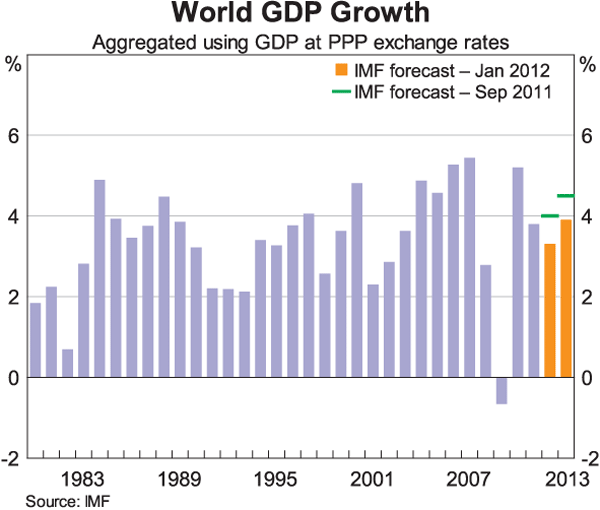
The downward revision is largely due to developments in Europe, with the European economy now seemingly in recession. What we are seeing there is a fundamental shift in fiscal policies. For more than 30 years, many European governments spent much more than they raised in revenues. And financial markets were prepared to finance the difference at low interest rates, apparently ignoring the steady build-up of debt. This, of course, has now all changed and this change is a wrenching experience for the countries concerned. The sharp economic contraction has led to large increases in budget deficits at a time when the tolerance of public debt has diminished and financial markets, after having ignored risks for many years, can now see risks everywhere.
These changes are also proving very difficult to manage. The task is made more complicated by having a single central bank, but many fiscal authorities. This set of arrangements has opened up issues that normally do not arise. Not least of these is the question of under what conditions is it appropriate for the single central bank to buy the government bonds of just one, or a few, of the members of the currency union. This is an issue that the Federal Reserve in the United States, the Bank of England and the Bank of Japan have not had to confront as they embarked on their own large-scale purchases of government debt in an effort to lower long-term yields.
Working through the various challenges is taking the Europeans time. The process has been frustratingly slow and we have witnessed some missteps along the way. But for all of that, we should not lose sight of the fact that progress is being made. Late last year there was a palpable sense that something might go badly wrong over our summer. Clearly, that has not happened. Instead, government bond yields for some of the troubled countries in Europe have declined a little (Graph 2). Equity markets have picked up and confidence has improved a bit. And significantly, bank debt markets are functioning again, although the cost of issuing bank debt, relative to government yields, is higher than it was in the middle of last year.
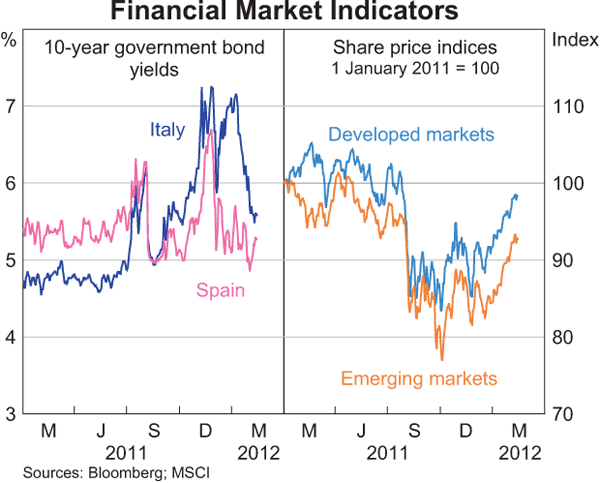
As my colleague, Guy Debelle, discussed earlier this week, an important development over recent months was the ECB's decision to make unlimited funds available (subject to adequate collateral) to the European banking system for three years at an interest rate of just 1 per cent.[1] All up, around ½ trillion euros have been lent and a further operation is scheduled to take place later this month. There has also been progress through the various euro-area summits in building political structures that, over time, have the prospect of delivering more disciplined fiscal policy than has been the case in the past.
Clearly, more will need to be done, and there is still the possibility of a very disorderly outcome in Europe. But, at least for the time being, the probability of this seems to have declined a little. Obviously how things play out on this front will have a major bearing on how the world economy evolves over 2012.
A related issue that I suspect will be discussed frequently in 2012 and beyond is the impact of fiscal consolidation on economic growth. Over 2012 and 2013, fiscal policy is set to be quite contractionary in both Europe and the United States as governments attempt to put their public finances on a sounder footing. Indeed, the aggregate fiscal contraction across the advanced economies is likely to be the largest seen for many decades. This is not because the size of the fiscal consolidations in individual countries is unprecedented, but rather because the consolidations are occurring simultaneously in a large number of countries. Unusually, they are also taking place in an environment where output in the affected countries is considerably below potential.
The economic literature is mixed on the effects of fiscal consolidation on growth. There are certainly some examples where consolidation has been associated with fairly strong GDP growth. But in most of these examples, the countries undertaking the fiscal consolidation have benefited from some combination of robust growth in their trading partners, an easing of monetary policy and a depreciation of their exchange rate. Given the nature of the current situation, it is unlikely that the advanced economies, as a whole, can benefit from these factors. There is therefore a material risk that fiscal consolidation weakens growth in the short run, which leads to more fiscal consolidation in order to meet previously announced targets and, in turn, yet weaker growth. We are currently seeing this dynamic play out in a couple of the countries in southern Europe. If it is not to be repeated on a wider scale, the fiscal consolidation in the North Atlantic economies will need to be accompanied by reforms to the supply side that lift the underlying rate of growth of these economies.
As interesting as the developments in Europe are, it is important that we do not lose sight of what is going on elsewhere in the world. In the United States, the recent data, particularly on the labour market, have been better than was widely expected (Graph 3). There are also some tentative signs of improvement in the housing market. Corporate balance sheets are generally in good shape and borrowing costs are low. While, undoubtedly, the US economy still faces many challenges, it does seem to have emerged from the soft patch in the middle of 2011 with some momentum.
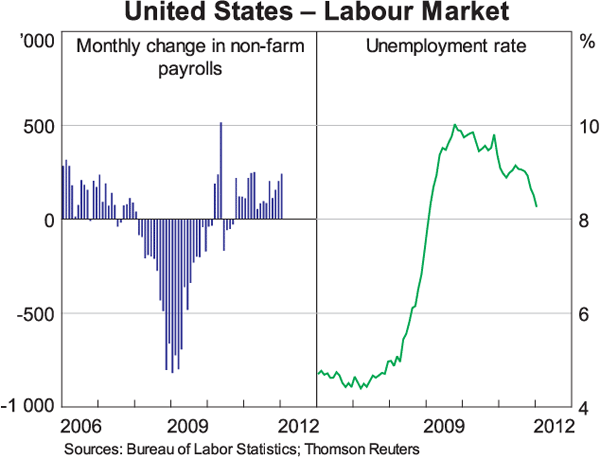
The Chinese economy is also continuing to grow solidly. The pace of growth has slowed, but it has done so in line with the authorities' intentions. Inflation in China has also moderated. Across the rest of east Asia, the recent data have been mixed. Nevertheless, for the region as a whole, growth in 2012 is expected to be around trend, with domestic demand likely to play a more important role in generating growth than it has for most of the past two decades.
Overall, as the IMF recently noted, the global risks still look to be tilted to the downside. But the better-than-expected US data and signs of some progress in Europe have lifted sentiment a little since the turn of the year. In January, business surveys for the manufacturing sector (the so-called PMIs) were up across the globe – in the United States, China, east Asia and even in the euro area (Graph 4). A similar picture is also evident in the available surveys for the services sector. While it is too early to be confident that this trend will continue, these timely surveys suggest that 2012 started a little better than many had expected.
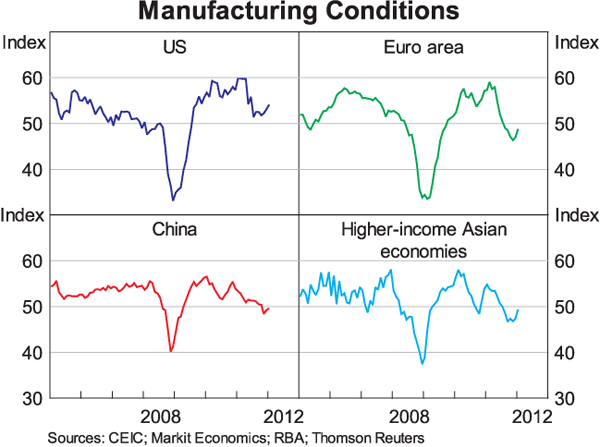
The Australian Economy
I would now like to turn to developments in Australia.
At the moment, the economy is being influenced by a large number of factors. These include the sovereign debt problems in Europe, the changes in household spending patterns, and the softness in the housing market. But this morning I would like to focus on the two factors that are perhaps having the most profound effects. And they are, on the one hand, the investment and terms of trade boom and, on the other, the very high exchange rate. These factors are, of course, interlinked, and in many respects are different sides of the same coin.
The investment boom in the resources sector, which the RBA has been discussing for some time, is clearly well underway. Over the past year, business investment has risen by around 20 per cent and there is more to come. Given the plans that have already been announced, the RBA is expecting double digit increases in business investment in each of the next couple of years. If this occurs, it would take the ratio of investment to GDP to a record level by a considerable margin (Graph 5).
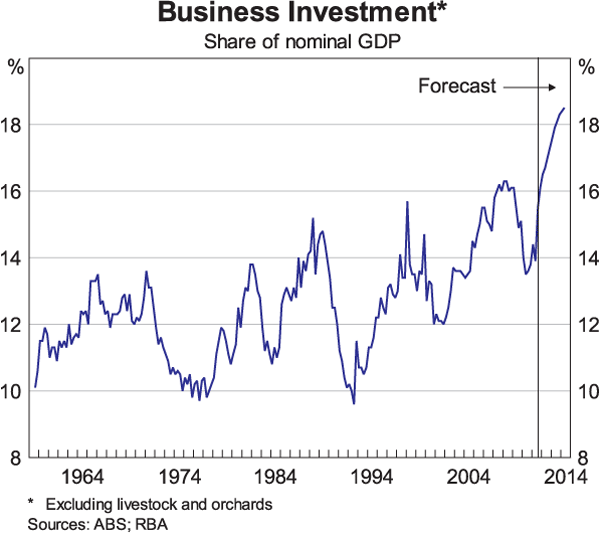
It is not an exaggeration to say that this is a once-in-a-century investment boom. It is, of course, occurring at a time when the terms of trade are also at a very high level, with the industrialisation and urbanisation of Asia supporting commodity prices and putting downward pressure on the prices of manufactured goods. This boom is having positive spill-over effects to a number of industries, with some of these effects being direct and others being indirect.
The indirect effects come through a variety of channels. Day to day, they can be hard to see but they do percolate through the economy. In effect, there is a chain that links the investment boom in the Pilbara and in Queensland to the increase in spending at cafés and restaurants in Melbourne and Sydney. This chain starts with the high terms of trade that has pushed up the Australian dollar. In turn, the high dollar has meant that the prices that Australians pay for many manufactured goods are, on average, no higher than they were a decade ago, despite average household incomes having increased by more than 60 per cent over this period. The stable prices for many goods, combined with strong disposable income growth means there is more disposable income to be spent on services in the cities and towns far from where the resources boom is taking place. As I said, this chain can be hard to see, but it is real, and it is one of the factors that have had a material effect on the Australian economy over recent years.
At the same time, the high exchange rate is having a contractionary effect on other parts of the economy, as it reduces the international competitiveness of some industries. Over recent months, the Australian dollar has appreciated despite the uncertainty about the global economic outlook and some decline in commodity prices since mid 2011. After adjusting for differences in inflation rates across countries, the exchange rate is currently at around its highest level since the early 1970s (Graph 6).
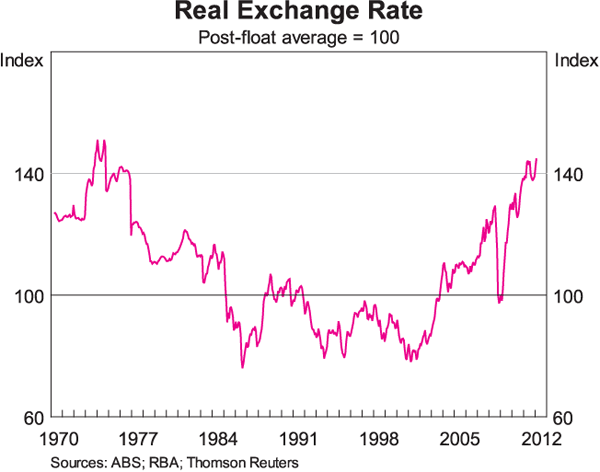
The effects of the high exchange rate are evident in the manufacturing, tourism and education sectors, as well as some parts of the agriculture sector and, more recently, in some business services sectors. With the exchange rate having been high for some time now, more businesses are re-evaluating their strategies, as well as their medium-term prospects. In some cases, this is prompting renewed investment to improve firms' international competitiveness. But in other cases, businesses are scaling back their operations in Australia and some are closing down. These changes are obviously very difficult for the firms and individuals involved.
Both the investment boom and the very high level of the exchange rate are historically very unusual events. This makes it difficult to assess their net effect. It seems, however, that over the past year these forces have balanced out reasonably evenly. Abstracting from the weather-related disruptions in early 2011, GDP growth over the year was likely to have been around trend. Underlying inflation was at the midpoint of the medium-term target range. The unemployment rate remained low at 5–5¼ per cent. And most lending rates in the economy were around average by end year.
It is fair to say that very few developed economies could make these same claims.
Looking forward, there are reasonable prospects that these favourable aggregate outcomes can continue for a while yet. The RBA's central forecasts, which were released last week, are for around trend growth in the economy over the next couple of years, and for underlying inflation to remain in the 2–3 per cent range. The unemployment rate is also expected to remain low, although some increase is possible over coming months.
At the industry level, the picture is a lot more complicated. The economy is clearly going through a period of heightened structural change, and this is set to continue. Some industries are expanding in relative importance, while others are contracting. Given this, it is difficult to be sure how the countervailing expansionary and contractionary forces will balance out. So at the RBA we are carefully examining every piece of data that comes in for insight into the net effect of these forces. We are also frequently talking to businesses and industry groups to better understand what is happening in firms at the forefront of structural change. It is the balance between these various forces that is likely to be a major influence on how the Australian economy evolves over 2012 and beyond.
Before I conclude, I would like to say just a few additional words about the outlook for inflation.
Over recent quarters, headline inflation has come down as expected due to the unwinding of the large rise in fruit and vegetable prices that occurred in early 2011 (Graph 7). Over the next few quarters further declines in the year-ended headline inflation rate are expected as the earlier increases in food prices fall out of the figures. Indeed, it is likely that the headline rate will fall below 2 per cent in the middle of 2012, before increasing again to above 3 per cent. This increase is partly due to the introduction of a price on carbon, which is estimated to add 0.7 percentage points to headline inflation in the 2013 financial year. As was the case with the introduction of the GST more than a decade ago, the Bank will look through this direct effect when setting monetary policy. In underlying terms, inflation is expected to remain within the 2–3 per cent range over the next couple of years, with the carbon price adding around ¼ percentage point to underlying inflation in the 2013 financial year.
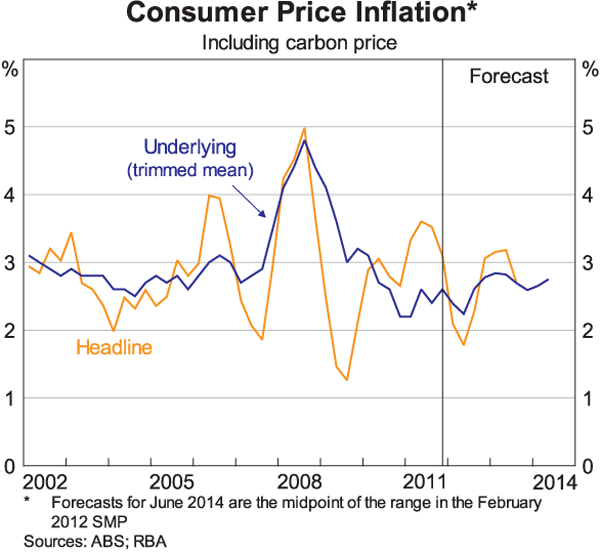
One interesting aspect of the recent inflation data is the divergent trends in the prices of internationally traded items and the prices of goods and services that are not internationally traded (Graph 8). Over recent times, the prices of non-traded goods and services have been increasing at a fairly firm pace, although down markedly from the rates in 2007 and 2008. The overall CPI inflation rate has, however, been held down by a decline in the prices of tradable goods as a result of the exchange rate appreciation. But the prices of these goods are unlikely to continue to fall over the medium term, particularly as the effects of the exchange rate appreciation dissipate. As a result, some slowing in the rate of increase in the prices of non-tradables is likely to be required at some point for overall inflation to remain consistent with the mid-point of the target range.
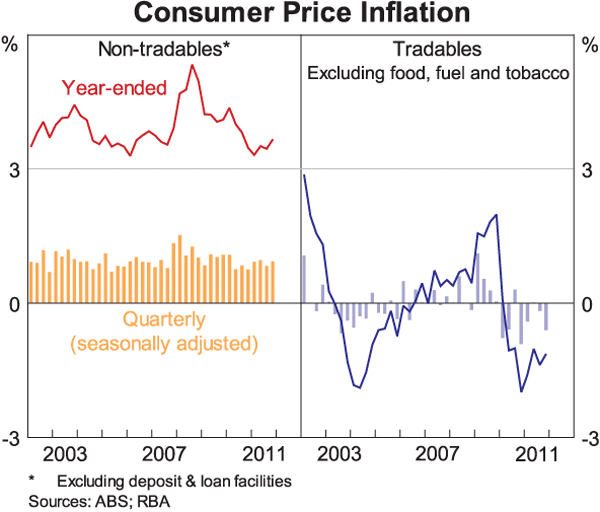
While we cannot be sure that non-tradables inflation will moderate, there are reasonable prospects that it will do so. The Bank is expecting a modest pick-up in productivity growth over the period ahead from the low rates of recent years, as well as a slight moderation in wage growth. Together, these developments would help lessen cost pressures in the economy and thus see some slowing in the rate of non-tradables inflation. In the event that they did not occur, it is likely that non-tradables inflation would be uncomfortably high.
Conclusion
So, to conclude, 2012 will no doubt again contain its fair share of surprises. Globally, we are seeing events that are historically very unusual, including widespread fiscal consolidation in the advanced economies and the rapid development of emerging market economies, with hundreds of millions of people entering the global economy. In Australia too, we are experiencing events that are historically unusual – a huge boom in investment and a very high exchange rate, both of which are related to the very high level of the terms of trade.
In this environment, economic forecasting seems to have more than the usual number of pitfalls. However, we can take some comfort from the fact that despite these powerful forces, the Australian economy started 2012 in relatively good shape. Growth has been around trend and inflation is consistent with the target, and there are reasonable prospects for this to continue. We also have much more flexibility to deal with unfolding events than almost any other developed economy.
I wish each of you success as you navigate your own way through 2012.
Endnote
Debelle, G, ‘On Europe's Effects on Australian Financial Markets’, Address to Bloomberg Seminar, Sydney, 14 February 2012. [1]